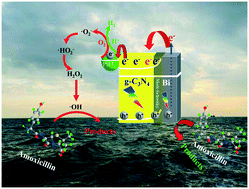Photocatalytic hydrogen energy evolution from antibiotic wastewater via metallic bi nanosphere doped g-C3N4: performances and mechanisms†
Abstract
In this work, bismuth nanosphere doped polymeric carbon nitride (Bi/g-C3N4) was applied for photocatalytically converting antibiotic wastewater into hydrogen energy. The physical and chemical properties of the samples were characterized by XRD, SEM, HADDF, element mapping, valence XPS, Mott–Schottky analysis and UV-vis spectroscopy. An amoxicillin solution was regarded as the model antibiotic wastewater, and its oxidation potential was realized via a cyclic voltammetry (CV) method. The experiment of photocatalytic hydrogen evolution from amoxicillin wastewater with different concentrations was fulfilled to provide evidence to gain insight into the waste to energy conversion. Mechanisms were investigated under different kinds of gases via a novel gas controlling method. The results showed that there was a negative relationship between the evolved hydrogen and the degradation of the contained drug. Interestingly, with the help of ESR spectroscopy, the main reason for this could be ascribed to the competition relationship between H+ and O2 to react with photoelectrons. More importantly, the pathways of amoxicillin degradation under the anaerobic environment were different from those in the aerobic atmosphere after exploring by HPLC-MS, which can be attributed to the different degradation mechanisms induced by electrons and ˙OH.

- This article is part of the themed collection: 2019 Catalysis Science & Technology HOT Articles


 Please wait while we load your content...
Please wait while we load your content...